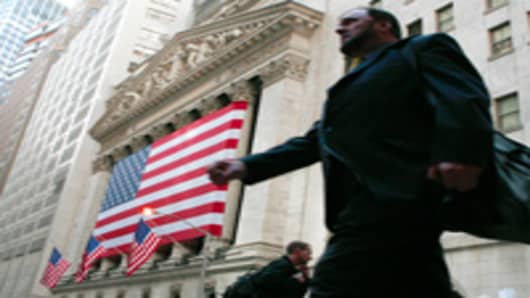The Fed's decision to pump more money into the economy will keep the dollar under pressure and should continue to add fuel to the risk rally.
In a much-anticipated announcement, the Fed Wednesday said it would purchase an additional $600 billion in Treasury securities by the end of the first half of next year.
"At least today, there was a really narrow gap between surprise and disappointment, and they threaded it right down the middle," said Jeff Kleintop, chief market strategist at LPL Financial. "I think what was a little bit of a surprise to me was the clarity around it."
Kleintop said the market will now turn its attention to the economic data against the backdrop of the promise of more Fed easing.
"We are past the earnings season. I think the market is going to watch very closely each week's economic data," he said, noting the Friday jobs report will be a big number for the market.
"As we get to Friday, if it (employment) does start to show signs of improvement, that's going to be what the market keys off of — whether the real-time economic data is going to show us whether the Fed is right," Kleintop added.
Thursday's markets will be digesting the Fed's decision, and monitoring the overseas reaction in the dollar, traders said. The Bank of England and European Central Bank both have rates meetings ahead of the U.S. open, and they will be watched to see if there is any reaction from those central banks.
Economic data includes the 8:30 a.m. reports on weekly jobless claims and productivity and costs. Chain stores will also be releasing monthly sales throughout the morning. Thomson Reuters forecasts that October sales for its index of retailers rose 1.6 percent. The best performers are expected to be discount, up 3 percent, followed by teen apparel chains, up 2.7 percent. The worst performers are expected to be drugs, down 0.5 percent.
"The initial claims will be important. Will they continue to dip. That looked like it might evident in last week's data," said Art Cashin, head of floor operations at UBS.
The Dow ended Wednesday up 26 at 11,215, and the S&P 500 was up 4 at 1197. The Nasdaq rose 6 to 2540. Since the market's July low, the Dow is now up 15.8 percent; the S&P 500 is up 17.1 percent and the Nasdaq is up 21.4 percent. Since the Fed first raised the idea of the new round of easing in late August, stocks have gained about 13 percent and the dollar has lost more than 10 percent against the euro .
The theory behind quantitative easing is that the Fed pumps new money into the economy with its purchases of Treasury securities, putting downward pressure on interest rates and helping to reflate asset prices.
Obama: Friendlier to Business?
Dan Greenhaus of Miller Tabak said the amount of easing the Fed announced is almost in line with market expectations but would not necessarily be enough to achieve the Fed's goal of lowering unemployment. The Fed is also targeting inflation which it has said is too low.
He said combined with an earlier plan to reinvest the money from expiring mortgage securities, the Fed's purchases could be $110 billion or more a month.
"They're buying a lot. All I'm saying is given the depth of the hole, you could make a case that they would have to buy a few trillion (dollars) worth of assets if you believe traditional models," he said.
Greenhaus noted the dollar should remain under pressure as the Fed eases.
"Just to be even with the lowest point of the dollar in 2008, it [the dollar index] could fall another 6.5 percent form here," Greenhaus said.
Alan Ruskin, head of G-10 currency strategy at Deutsche Bank, said the Fed's move comes just as other central banks are finding they have to move in the other direction. One example of that is Australia, which raised rates earlier this week.
"Obviously if the U.S. economic data continues to come out somewhat on the stronger side, particularly if you have validation in the employment report, people will say the QE stuff is temporary, which will undercut the idea of the U.S. swimming one way and the other guys swimming the other way," Ruskin said. "There would be some assumption that the U.S. would swim in the same way as the rest of the world and at some point move away from printing dollars and start tightening. The idea now is to use the dollar as a cheap financing vehicle."
Kleintop said stocks may trade more choppily toward the end of the year, until it's clear what actions Congress will take with regard to the expiring Bush tax cuts. He said he expects a compromise to be worked out between Congress and the Obama administration, and he expects to see all of the tax cuts extended. But before that some investors, fearing higher capital gains and dividend taxes, may move to sell stocks, causing more volatility.
President Obama Wednesday admitted that he was humbled by the huge Republican win in Congress, which gave the GOP control of the House. He also admitted he hasn't necessarily been seen as a friend to business, as his administration moved to toughen regulations.
"The important thing we can do is boost and encourage our business sector and make sure they're hiring," the president said during an afternoon press conference. He vowed to work with the new Republican leadership.
Companies reporting earnings Thursday include Cablevision, DirecTV, Sirius XM Radio , Time Warner Cable, Unilever , Kraft Foods , Activision Blizzard, Starbucks , Tesoro, Toyota, DISH Network, Liberty Media, Washington Post and Berkshire Hathaway .
- Follow me on Twitter @pattidomm.
Questions? Comments? Email us at marketinsider@cnbc.com




